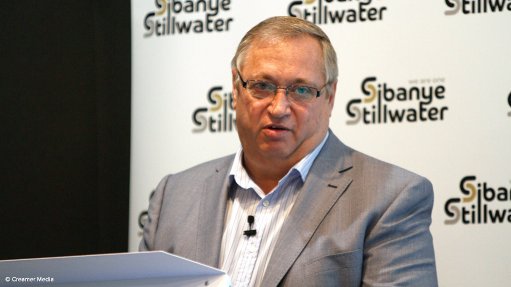
Sibanye-Stillwater CEO Neal Froneman
JOHANNESBURG (miningweekly.com) – Precious metals miner Sibanye-Stillwater on Monday lowered its production guidance for its South African gold mines, following production stoppages as a result of a spate of deaths in the first six months of the year.
The company said that its South African operations would produce 6% less gold than previously thought, with the guidance for the year to December 2018 having been lowered to between 36 500 kg and 37 500 kg, or about 1.17-million ounces and 1.21-million ounces.
All-in sustaining costs (AISC) are expected to increase and have been revised to between R515 000/kg and R530 000/kg, or to between $1 227/oz and $1 263/oz.
These revisions are primarily owing to operational disruptions following safety-related incidents at the Kloof and Driefontein operations, as well as power disruption earlier in the year at Beatrix.
Damage to the footwall infrastructure, which provides access to the western side of the Masakhane mine, following a seismic event on May 3, also had an impact. The resumption of full production of about 250 kg/m, or 8 038 oz/m, from the Masakhane in April 2019, should result in production from the South African gold operations increasing in 2019, CEO Neal Froneman said.
In the first six months of 2018, 21 people have been killed at the South African gold mines of JSE- and NYSE-listed Sibanye, making it the deadliest half-year period in the five-year old company’s history. Sibanye accounts for nearly half of the fatalities that have occurred in the South African mining industry the first six months of the year.
Froneman has committed to improve the safety of the miner’s operations and on Monday also outlined a 12-point plan to address safety concerns.
While some of the action steps are still being fully developed, he said that several steps in this plan had already been implemented.
The first step encompassed a multi-stakeholder health and safety summit in May, which Sibanye said was well attended the unions, the Department of Mineral Resources, as well as senior management from the company.
The second step involves funding an independent study by a leading academic at the University of the Witwatersrand in Johannesburg, with the aim of developing practical recommendations for enhancing risk management effectiveness at Sibanye’s operations, Froneman elaborated on a conference call.
This work, which forms part of a wider study on the origins and impact of the Mine Health and Safety Act, will be performed through the Wits’ Centre for Sustainability in Mining and Industry.
Thirdly, the miner has appointed mine safety expert, Dr Kobus de Jager, as corporate head of safety. His primary responsibility will be to review the company’s safety management systems and processes.
The fourth step is the company’s sponsorship of digimines, which Froneman said “is a collaborative partnership with the University of the Witwatersrand”. Digimine is expected to complement these initiatives through the provision of digital solutions that enhance the timely availability of information to improve safety and operating effectiveness.
As a fifth step, Sibanye will be holding a safety day at all its operations, which will be dedicated to recommitting to safe operations and reinforcing the rights of employees. The miner also aims to fix workplaces to a standard through an intensive safe declaration process on these safety days.
The remaining steps towards achieving a zero-harm environment require the commitment and support of all stakeholders, Froneman noted, which were encapsulated in the outcomes of the second health and safety summit that was held on Friday.
Froneman further reiterated the company’s commitment to providing a safe working environment, stating that Sibanye would “do everything it can to eliminate the loss of life at its operations as the company work towards zero-harm in the workplace”.
The spate of deaths at Sibanye has sparked outrage from labour unions and has led to a potential class action lawsuit in the US.
Last week, US law firm Bernstein Liebhard said it would file a class action suit on behalf of shareholders to recover losses after the mine fatalities triggered a sharp fall in the company’s share price.
Froneman said that while comment on the class action lawsuit was still premature, he stressed that the company would “vigorously” defend itself.
Meanwhile, Sibanye said that its South African platinum group metals (PGMs) operations had maintained their strong performance from the first quarter and that its 4E PGM production was likely to be at the upper limit of its 1.1-million ounce to 1.15-million ounce guidance. Its AISC is also expected to be towards the bottom end of the guidance of between R10 750/oz and R11 250/oz of 4E.
Production from its US PGM opeartions for the year ended December 31, 2018, is maintained at between 580 000 oz and 610 000 oz, with AISC between $640/oz and $680/oz of 2E.